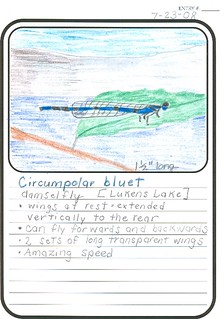
This summer has been filled with lots of dragonflies and damselflies and it has made me more aware of the variety of life we have all around us that we sometimes forget to notice.
Here is a great website that will help you with your state’s dragonfly and damselfly identification. http://www.npwrc.usgs.gov/resource/distr/insects/dfly/index.htm

I learned how to tell a dragonfly from a damselfly this summer. Here are some facts that should help you in your identification.
Dragonflies
- Generally strong fliers
- Eyes touch on top of the head
- Forewings and hind-wings are of different shape
- At rest, the wings are held away from the body at an angle of approximately 180°
- A weak, fluttery flight
- Eyes are well separated
- Forewings and hind-wings are of similar shape
- At rest, the wings are held close to the body

Outdoor Hour Challenge #28
Focus on Insects-Dragonflies and Damselflies
1. This week read about dragonflies and damselflies in the Handbook of Nature Study, pages 401-408. You also may enjoy reading page 400-401 about the insects of the brook and pond. Remember our focus right now is on insects so if you don’t find a dragonfly or a damselfly to observe, you can always look for other insects to study.
“A pond without dragonflies darting about it, or without the exquisitely iridescent damsel flies clinging to the leaves of its border would be a lonely place indeed.”2. Your 15-20 minutes of outdoor time this week can be spent looking for insects. If you have access to a pond, this would be a great week to make a short trip to the pond’s edge to make some observations. If you are sticking close to home and in your own backyard, look for any insects that you can observe. Remember to look under rocks (carefully if you live in snake country), under logs, on tree trunks, on the backsides of leaves, inside a flower, in a flowering bush or tree, and even in your window sill.
Handbook of Nature Study, page 401

3. Give the opportunity for a nature journal entry. Dragonflies and damselflies are lots of fun to draw. Here is a website that tells you step by step how to draw a dragonfly…try it together as a family.
http://library.thinkquest.org/J001401/bug%20drawings/howtodrawthedragonfly.htm (or you could just Google “how to draw a dragonfly”)
4. If you are keeping a running list of insects you have observed during this focus period, add any new insect names to your list. This is our last week to focus on insects in the Outdoor Hour Challenges. It might be enjoyable to take a few minutes this week to review the insects you have learned about and observed during the last seven weeks with your children. If you have a list of insects that you have observed, make sure it is complete before we move on to something new next week.
5. Post an entry on your blog sharing your experiences and then come back to the Outdoor Hour Challenge post and add your blog link to Mr. Linky. All the challenges are listed on the sidebar and top tabs of the Handbook of Nature Study blog.
If you would like to print out this challenge, here is a link to the PDF file for you to download.
Outdoor Hour Challenges #28 Dragonflies and Damselflies
(complete set of insect challenges #22-28 in one document)
You may be interested in other insect challenges here on the Handbook of Nature Study:
#22 Butterflies
#23 Moths
#24 Crickets
#25 Housefly
#26 Ladybugs/Aphids
#27 Bees
Winter Wednesday - Winter Insect Study
Ants (Spring)
Mosquito
Moths and Fireflies
Crickets, Grasshoppers, and Katydids
Leaf-Miners and Leaf-Rollers
